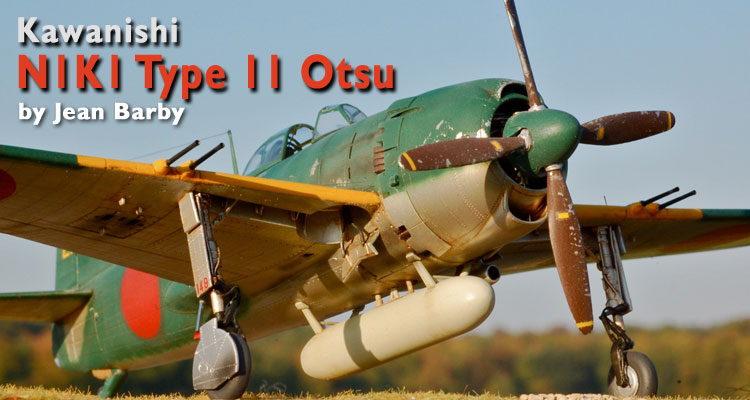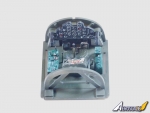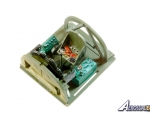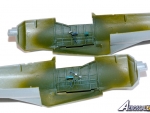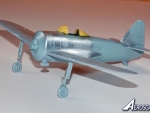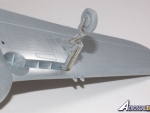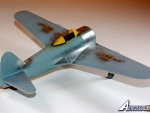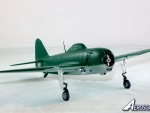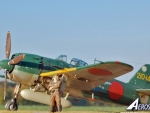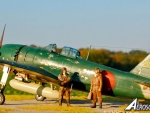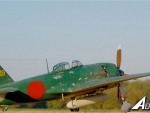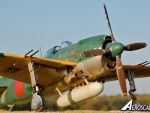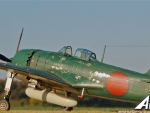1⁄48Kawanishi N1K1 Type 11 Otsu
15
Comments
Here are some WIP and final pics of my Hasegawa Kawanishi N1K1b Mod 11 Otsu. The main difference with the previous Mod a, being the relocation of the four Type 97 20mm guns in the wings.
This model is not often seen, and it's a pity as she looks so good! Natural metal undersides, Kawanishi Green on top, riveting and chipping on the house!
This model is not often seen, and it's a pity as she looks so good! Natural metal undersides, Kawanishi Green on top, riveting and chipping on the house!
Comments
Beautiful clean work Jean! I liked the chipping too, which is hard to get to look right...
Here is a comparison made by another modeller of Tamiya's N1K1 with Hasegawa's: Hasegawa's kit is much better...:
John Acosta (Quote):
"Well lets face it most modelers are interested in the more common aircraft. And they think that the Tamiya kit is just fine (even though it suffers from some uncorrectable and innaccurate shape problems, more later.) Most modelers will also complain that the subject is just another boring "green over grey" paint scheme, even though they've sprayed enough OD/NG, lichtblau, and Dunkle grun to cover their houses.
I can say that I'm happy Hasegawa did this kit. I received my Hasegawa Shiden a couple of weeks ago from Hobby Link Japan, but I've been waiting to borrow a digital camera from a friend (Yes I'm still living in the 20th Century, my Cannon F-1 has served me well all these years.), so I can post some photos of the differences between the Hasegawa and Tamiya kits. I used to think that the Tamiya kit was fine and that it only suffered from an inaccurate cowl, but I was wrong. (By the way I have built Tamiya's N1K1-Ja and used Eduard's photoetch set on it. I also have an unbuilt Tamiya kit, which I used to compare to the Hasegawa).
Now on to the kit match up. I have Model Art #587 which has 1/48 scale drawings of the Shiden in it and I compared both the Tamiya kit and the Hasegawa kit to these scale plans, as well as photographs of the actual aircraft in both MA #587 and FAOW #53. Well it turns out that the Hasegawa kit is pretty much spot on, while the Tamiya kit is about 1.5mm short from nose to tail. The Tamiya kit is also 2 to 3mm too deep in the belly. This was carried over to the cowl, which causes it to be oval rather than round in shape. This also results in the oil cooler intake, on the bottom of the cowl, being to shallow. Also Tamiya set the carburetor intake, which is on top of the cowl, back from the nose. It should be flush with the front of the cowl when looking at it from the side.
Moving on to the gear legs. Well, Tamiya's suffer from some problems as well. The tires and rims aren't like anything seen on the Shiden. They are mere toy-like discs compared to the Hasegawa kit. Hasegawa molded the proper spokes on one side and rim on the other. Hasegawa's gearlegs are also of the proper shape and dimension. The fork itself has the curves seen on the Shiden, however Tamiya's are too bulky and not shaped correctly. As for the oleo scissors: Tamiya's are thick lumps of plastic which can be corrected by using Eduard's photoecth set, Hasegawa molded the lower scissor as a separate part which gives a better result than Tamiya's oob offering.
I am a little disappointed with the cockpit on the Hasegawa kit. It doesn't seem up to the standards the set with the Ki-84 or even the Shiden-kai. Hopefully FM will do a resin set for this kit as they have done masterful work on their Ki-43, Ki-44, and Ki-84 sets. I would have liked to see the decal sheet with a clear decal with instruments on it rather than the solid black decal with instrument on it. I used my Waldron set on this and punched out the individual instrument decals and placed them on the panel.
The Hasegawa kit also contains a set of elevators which were used on the N1K1-Jb which mounted all four cannon in the wings, so hopefully we will see this version as well as the single exhaust Shiden since the parts break down allows for this.
Overall I can highly recommend Hasegawa's 1/48 scale Shiden. It really looks like a Shiden and it corrects all the errors of the misshapen Tamiya kit. It contains just 87 parts, so it should be a very quick build. In fact mine is already all glued together and I'm working on taking care of the surface to get it ready to paint! I will also be using Fine Molds brass cannons for this kit. They look really nice on the completed model.
For those of you who are planning on building this kit you can still get the FAOW #53 covering the Kyofu, Shiden, and Shiden-kai from Arawasi.jp or Hobby Link Japan. You can also get the Fine Molds Cannon barrels from HLJ.
Also before painting your Shiden please check your references. These were Navy birds. The officers kept their sailor busy painting, so except for the Shidens sent to the Philippines, these aircraft showed minimal wear. Also Kawanishi used a green with a slight blue tint to it, the undersides were NMF!
I hope my peep has been of help."
Regards,
John Acosta
Because a WWII fighter fuselage is typically 6 to 7 times longer than it is high, I consider a 1 mm error in depth to be equivalent to 6 mm, or a foot in the length (the appearance of the error is the same)... I consider 1 mm of depth error on a small WWII fighter to be a write off, so the 2 or 3 mm mentionned here on the Tamiya kit are pretty serious...
The most accurate Tamiya kit of a mass-produced Japanese WWII aircraft is in my opinion the Ki-46 Dinah: It is outstanding, especially with a Falcon canopy. The new Zero has small but hard to fix errors, like the aileron chord or fin slope... And yes, the tail is 0.5 mm too long before the rudder post... The J1N1 "Irving" is very nice but could use a slightly narrower windscreen. Hasegawa's J2M3, C6N and F1M are all pretty amazing in accuracy...
Gaston
OCT 30, 2011 - 03:38 PM
Chuck while you spend time looking at my models, the HS world is crying for a Ju388 suite with saukraut and gretchen! Thanks my friend and take care! Jean;
OCT 30, 2011 - 11:46 PM
Hi Jean,
Very well done! I concur that your chipping and overall weathering is excellent.
AUG 18, 2013 - 05:44 AM
Love it. Nothing gets me interested more than Japanese fighters. Great work, especially on those pilots!
AUG 18, 2013 - 08:20 AM
Jean, another outstanding build. Your painting and weathering is just perfect. Paint chipping isn't heavy handed, nor over done.
Gaston, thanks so much for supplying us with the comparison review of both the Hasegawa and Tamiya kits. I'm rather surprised that Tamiya missed the mark by so much. Maybe Mr.T should spend more time over seeing the aircraft production, rather then his personal favorite: 1/12 scale F1 race cars.
Joel
AUG 19, 2013 - 11:33 AM
If the Fi-156 and Il-2 are any guide, then indeed he should...
Compared to their 1/32 range, Tamiya's 1/48th aircraft range is a poor downtrodden cousin: A few Trumpeteer and Hobby Boss kits are better than about 75+% of Tamiya's all-new quaterscale WWII aircraft releases of the last 14 years, which amounts to a grand total of nine aircrafts... (Tamiya's 1/48th armor is admittedly way better, especially now.)
Of those nine kits I consider only 2 to be really good, the Zero and the Swordfish, with a possible third with the J1N1, if a smash-moulded canopy can fix the too-wide windshield...
The He-162 is fixable as well... Beyond that I've found the Tamiya P-47's wings useful on an Otaki fuselage, as are the Tamiya's Me-262 wings on the Monogram fuselage.
They do have their uses...
Gaston
AUG 19, 2013 - 05:12 PM
Hi Gaston,
Intriguing. Otaki has all those oversized recessed rivets, do you fill them? Otherwise I surmise the smooth Tamiya wings will clash with the Otaki molding.
Monogram's ME 262 is better than Tamiya's? I have read that Monogram is an accurate kit.
Will you post photos of them?
AUG 19, 2013 - 06:28 PM
I will post photos of those builds.
The Otaki P-47 happens to be one of those few Otaki kits devoid of rivets: It just has very fine panel lines....
The Otaki fuselage in plan view has correct paralell sides, which the Tamiya kit does not, being "swollen" by 2 mm in the middle, this carrying on to its cowling which is tapered: The cowling shouldn't be tapered but paralell like the fuselage...
I'll admit I never saw this, but once pointed out by Yoyuso...:
LINK
LINK
...It made the Tamiya fuselage seem totally unacceptable to me: His method of correcting this seems a bit daunting...
I had on the other hand noticed the bad Tamiya clear parts, which are far more obvious to my eyes (which he strangely ignored)... The Otaki clear parts are too heavily framed, but if that is erased by smash-moulding the parts smoothed with putty, then they are more accurate than Tamiya's clear part in the way they join their own fuselage.
The Otaki fuselage is a dead match in profile to the Tamiya, but the Otaki cowl has lips that are too round: This is one area the Tamiya cowl could have its front section gainfully transplanted to the Otaki part... It would be difficut to adapt the whole Tamiya de-tapered cowl to the Otaki kit, but some might find this preferrable...
The funny thing is that the Otaki wings are very poor, with much too thick leading edges, and don't match their own fuselage wingroot fairings(!), while the Tamiya wings do match the Otaki wingroot fairings quite well... (The Tamiya wings are exceptional, in that they replicate the wingtip leading edge "washout") It takes a lot of careful carving to ensure correct dihedral symmetry, but the wingroot profile are a good match...: Here's few pics showing how they go on:

 Putting Tamiya wings on the Monogram 262 is much easier. These Tamiya wings have the more correct 3 mm greater span, but the one-piece trailing edges are a bear to sharpen, and the lack of separate leading edge slats a big minus...
Gaston
Putting Tamiya wings on the Monogram 262 is much easier. These Tamiya wings have the more correct 3 mm greater span, but the one-piece trailing edges are a bear to sharpen, and the lack of separate leading edge slats a big minus...
Gaston

 Putting Tamiya wings on the Monogram 262 is much easier. These Tamiya wings have the more correct 3 mm greater span, but the one-piece trailing edges are a bear to sharpen, and the lack of separate leading edge slats a big minus...
Gaston
Putting Tamiya wings on the Monogram 262 is much easier. These Tamiya wings have the more correct 3 mm greater span, but the one-piece trailing edges are a bear to sharpen, and the lack of separate leading edge slats a big minus...
Gaston
AUG 20, 2013 - 07:40 PM
Copyright ©2021 by Jean Barby. Images also by copyright holder unless otherwise noted. The views and opinions expressed herein are solely the views and opinions of the authors and/or contributors to this Web site and do not necessarily represent the views and/or opinions of AeroScale, KitMaker Network, or Silver Star Enterrpises. Images also by copyright holder unless otherwise noted. Opinions expressed are those of the author(s) and not necessarily those of AeroScale. All rights reserved. Originally published on: 2011-10-29 00:00:00. Unique Reads: 9361




